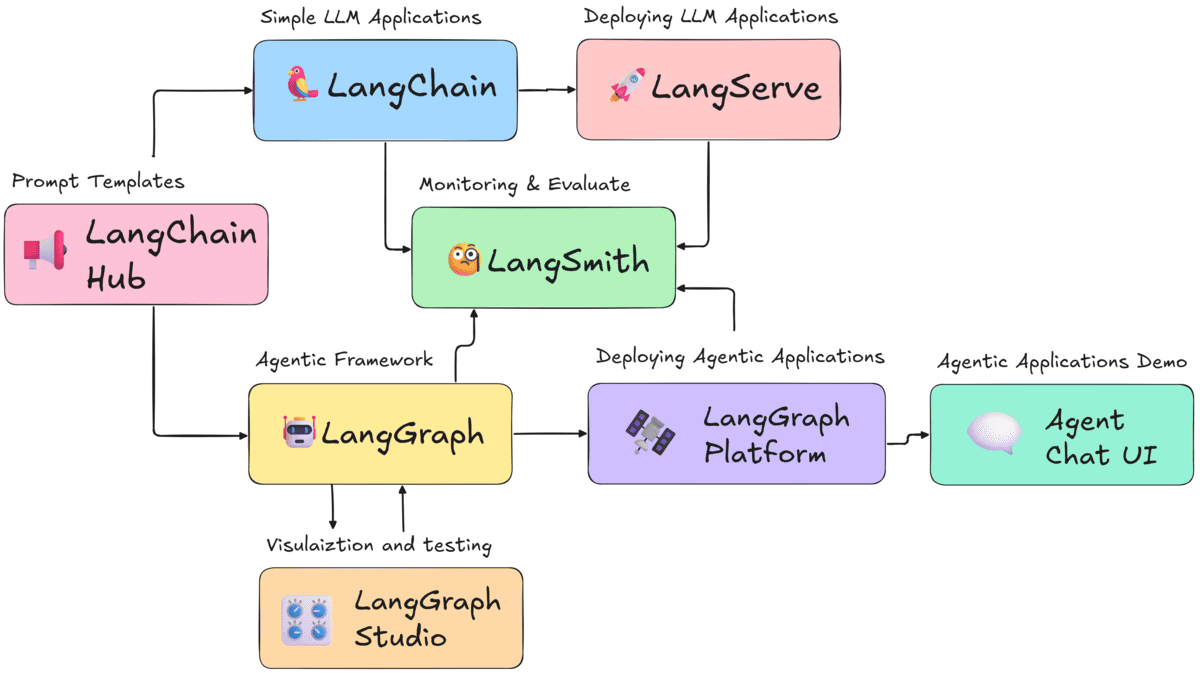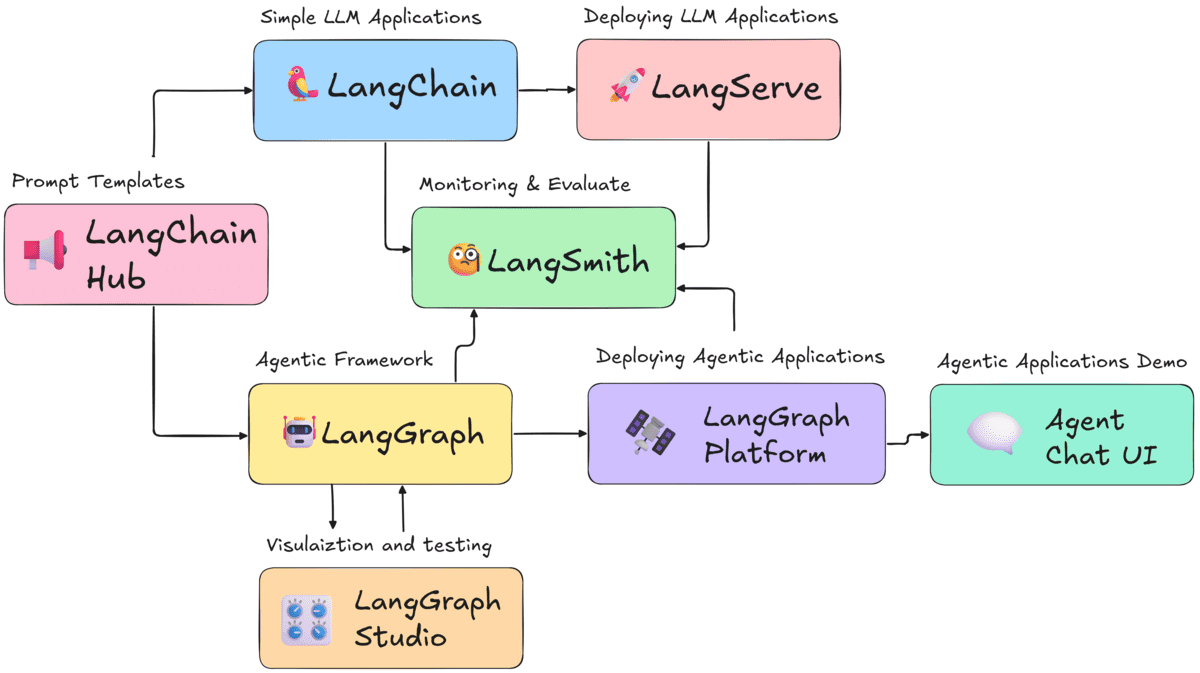AI in Travel
Getting The Most From The LangChain Ecosystem

 Image by Author
Image by Author# Introduction
Building complex AI systems is no small feat, especially when aiming for production-ready, scalable, and maintainable solutions. Through my recent participation in agentic AI competitions, I have realized that even with a wide array of frameworks available, constructing robust AI agent workflows remains a challenge.
Despite some criticism in the community, I have found that the LangChain ecosystem stands out for its practicality, modularity, and rapid development capabilities.
In this article, I will walk you through how to leverage LangChain’s ecosystem for building, testing, deploying, monitoring, and visualizing AI systems, showing how each component plays its part in the modern AI pipeline.
# 1. The Foundation: The Core Python Packages
LangChain is one of the most popular LLM frameworks on GitHub. It consists of numerous integrations with AI models, tools, databases, and more. The LangChain package includes chains, agents, and retrieval systems that will help you build intelligent AI applications in minutes.
It comprises two core components:
- langchain-core: The foundation, providing essential abstractions and the LangChain Expression Language (LCEL) for composing and connecting components.
- langchain-community: A vast collection of third-party integrations, from vector stores to new model providers, making it easy to extend your application without bloating the core library.
This modular design keeps LangChain lightweight, flexible, and ready for rapid development of intelligent AI applications.
# 2. The Command Center: LangSmith
LangSmith allows you to trace and understand the step-by-step behavior of your application, even for non-deterministic agentic systems. It is the unified platform that gives you the X-ray vision you need for debugging, testing, and monitoring.
Key Features:
- Tracing & Debugging: See the exact inputs, outputs, tool calls, latency, and token counts for every step in your chain or agent.
- Testing & Evaluation: Collect user feedback and annotate runs to build high-quality test datasets. Run automated evaluations to measure performance and prevent regressions.
- Monitoring & Alerts: In production, you can set up real-time alerts on error rates, latency, or user feedback scores to catch failures before your customers do.
# 3. The Architect for Complex Logic: LangGraph & LangGraph Studio
LangGraph is popular for creating agentic AI applications where multiple agents with various tools work together to solve complex problems. When a linear approach (LangChain) isn’t sufficient, LangGraph becomes essential.
- LangGraph: Build stateful, multi-actor applications by representing them as graphs. Instead of a simple input-to-output chain, you define nodes (actors or tools) and edges (the logic that directs the flow), enabling loops and conditional logic essential for building controllable agents.
- LangGraph Studio: This is the visual companion to LangGraph. It allows you to visualize, prototype, and debug your agent’s interactions in a graphical interface.
- LangGraph Platform: After designing your agent, use the LangGraph Platform to deploy, manage, and scale long-running, stateful workflows. It integrates seamlessly with LangSmith and LangGraph Studio.
# 4. The Shared Parts Depot: LangChain Hub
The LangChain Hub is a central, version-controlled repository for discovering and sharing high-quality prompts and runnable objects. This decouples your application logic from the prompt’s content, making it easy to find expertly crafted prompts for common tasks and manage your own team’s prompts for consistency.
# 5. From Code to Production: LangServe, Templates, and UIs
Once your LangChain application is ready and tested, deploying it is simple with the right tools:
- LangServe: Instantly turn your LangChain runnables and chains into a production-ready REST API, complete with auto-generated docs, streaming, batching, and built-in monitoring.
- LangGraph Platform: For more complex workflows and agent orchestration, use LangGraph Platform to deploy and manage advanced multi-step or multi-agent systems.
- Templates & UIs: Accelerate development with ready-made templates and user interfaces, such as agent-chat-ui, making it easy to build and interact with your agents right away.
# Putting It All Together: A Modern Workflow
Here’s how the LangChain ecosystem supports every stage of your AI application lifecycle, from idea to production:
- Ideate & Prototype: Use langchain-core and langchain-community to pull in the right models and data sources. Grab a battle-tested prompt from the LangChain Hub.
- Debug & Refine: From the beginning, have LangSmith running. Trace every execution to understand exactly what’s happening under the hood.
- Add Complexity: When your logic needs loops and statefulness, refactor it using LangGraph. Visualize and debug the complex flow with LangGraph Studio.
- Test & Evaluate: Use LangSmith to collect interesting edge cases and create test datasets. Set up automated evaluations to ensure your application’s quality is consistently improving.
- Deploy & Monitor: Deploy your agent using the LangGraph Platform for a scalable, stateful workflow. For simpler chains, use LangServe to create a REST API. Set up LangSmith Alerts to monitor your app in production.
# Final Thoughts
Many popular frameworks like CrewAI are actually built on top of the LangChain ecosystem. Instead of adding extra layers, you can streamline your workflow by using LangChain, LangGraph, and their native tools to build, test, deploy, and monitor complex AI applications.
After building and deploying multiple projects, I have learned that sticking with the core LangChain stack keeps things simple, flexible, and production-ready.
Why complicate things with extra dependencies when the LangChain ecosystem already provides everything you need for modern AI development?
Abid Ali Awan (@1abidaliawan) is a certified data scientist professional who loves building machine learning models. Currently, he is focusing on content creation and writing technical blogs on machine learning and data science technologies. Abid holds a Master’s degree in technology management and a bachelor’s degree in telecommunication engineering. His vision is to build an AI product using a graph neural network for students struggling with mental illness.
AI in Travel
Booking.com unveils its Global AI Sentiment Report

Booking.com has unveiled The Global AI Sentiment Report, a major new study exploring how consumers across 33 markets perceive and interact with artificial intelligence in everyday life and travel.
Drawing on responses from over 37,000 people, the report paints a complex picture: while excitement around AI is high, concerns about trust, transparency, and human oversight remain key barriers to broader adoption.
High interest, low trust
Globally, 91% of respondents to booking.com survey said they are excited about Artificial Intelligence. 89% expressed interest in using AI tools for future travel planning. However, only 6% reported fully trusting AI. 42% declared to always fact-check AI outputs, while 29% do so sometimes. Just 12% feel comfortable with AI making decisions without human input, and 10% are strongly opposed to it. Most consumers appear to value AI more as a support tool than a replacement for human judgment.
Booking.com report categorizes consumers into distinct groups: 36% are “AI Enthusiasts” intrigued by the technology’s potential, 13% are “AI Advocates” who champion its responsible adoption.
However, this excitement coexists also with significant caution. While 25% are “AI Detractors,” showing active resistance. Another 13% are “AI Cautious,” expressing reservations about its growing influence.
While 91% acknowledge at least one benefit—such as time-saving (51%), improved productivity (40%), or learning support (48%)—an equal percentage also reported at least one concern.
Regional gaps in trust and AI recognition
Regional variation reshapes Artificial Intelligence perception from one continent to another. Latin America (LATAM) leads in AI positivity, with 98% of respondents excited about the technology and 89% saying they understand how it works. Asia-Pacific (ASPAC) follows closely with 95% in excitement feeling and 82% being familiar with IA. ASPAC users have a widespread daily integration of AI, especially in transport and education.
Globally, while 77% have at least some trust in AI, nearly a quarter (23%) rarely or never trust information generated by it. It is particularly high in North America (NORAM) and Europe & the Middle East (EME). The two regions show higher distrust with 32% and 29% of respondents respectively feeling cautious at AI-generated information. Consumers here are highlighting a broader demand for transparency and reassurance as adoption grows.
In the travel sector, AI is already widely used. Two-thirds of respondents have relied on AI for trip planning, booking, or in-destination assistance. Travelers primarily use AI to research destinations (38%), find cultural experiences (37%), and get restaurant tips (36%). Once on the ground, translation tools (45%) and navigation help (40%) are the most common applications. Photo editing tops AI usage post-trip.
The report also highlights growing demand for ethical AI. A majority of travelers (71%) value tools that help avoid crowds, and 60% want Artificial Intelligence to prioritize experiences that support local communities.
“Generative AI represents one of the most significant technological shifts of our era. It fundamentally reshapes how consumers engage with the world around them, ” says James Waters, Chief Business Officer at Booking.com. “But beyond innovation, our focus must be on transparency, trust, and responsibility as we move into the next chapter of travel technology.”
Related News Stories: Amex GBT integrates hotel marketplace with Concur Travel platform AI takes the lead in travel booking – but human touch remains the … Booking.com to cut jobs With Alipay+ Voyager, Ant International provides an AI travel … Global Travel Tech Leader HotelPlanner Partners with UPA Asia … Smarter Reservations: AI, Customer Experience, and Dylan … Hostaway launches full suite of AI tools HotelPlanner partners with The Lawn Tennis Association B2B booking Teldar Travel enters the U.S. and Middle East markets HotelPlanner: How AI and human booking agents can thrive together
AI in Travel
Air Travel Pricing: Delta’s AI fare strategy: Cheaper flights or high-tech price hikes?

How it works: AI-powered dynamic pricing
Delta’s AI system, developed by Israeli startup Fetcherr, analyzes a wide range of data in real time such as demand trends, market fluctuations, booking pace, and competitor pricing. Rather than using static fare charts, the AI suggests optimal prices that can adapt instantly to changing conditions.
Delta President Glen Hauenstein called it a “reengineering” of pricing science and noted early trials have led to “amazingly favorable unit revenues,” a metric used to gauge profitability per seat.
Concerns over fairness and transparency
Despite Delta’s optimism, the move has sparked concern among lawmakers and consumer advocates. Senators Mark Warner, Richard Blumenthal, and Ruben Gallego sent a letter to the airline questioning whether AI driven fare decisions could lead to “surveillance pricing.” Their concern: that AI might use personal data to charge individuals based on their perceived willingness to pay.
Delta responds: No personal data used
Delta has firmly denied using personal information to set prices. In a statement, the airline clarified that it does not use browsing history, financial details, or customer profiles. Instead, pricing is based on anonymized market data and traditional travel factors like origin, destination, date, seat class, and refundability. “All customers have access to the same fares,” a Delta spokesperson emphasized.
A broader trend in air travel?
Industry analysts suggest this is just the beginning. As airlines compete for profitability in a volatile market, many are likely to adopt AI tools to gain an edge. While dynamic pricing isn’t new, the speed and granularity offered by AI raises concerns about fairness and transparency.Consumer rights groups are keeping a close eye on the issue. A new bill in Congress, called the Stop AI Price Gouging and Wage Fixing Act, seeks to ban the use of consumer profiling in pricing and could impact how AI tools like these are used in the future.
FAQs
Q1. What is Delta’s AI pricing system?
A1. Delta is using artificial intelligence to set ticket prices based on real-time market data. The system is designed to optimize fares depending on demand, competition, and booking trends.
Q2. How could AI-based pricing affect travelers?
A2. Travelers may see more frequent changes in fares based on demand and timing. It might get harder to know when you’re getting the best deal.
AI in Travel
New York City Launches New AI Travel Guide

Travelers heading to New York City now have one more tool in their arsenal to help them experience the city, an AI chat platform called Libby, short for Liberty.
The new AI tool, available on New York City Tourism + Conventions’ website on the lower right-hand side, along with the city’s official Instagram and WhatsApp, is available in 60 different languages and will provide quick answers to any travel or tourism-related questions about the city.
The responses travelers receive are personalized with extensive data from the tourism organization.
“We’re pleased to unveil Libby, the official AI chat platform for exploring New York City,” says Julie Coker, president and CEO of New York City Tourism + Conventions. “As we gear up for America 250 celebrations and the 2026 FIFA World Cup, we’re proud to offer this free, innovative tool in 60 languages that empowers global visitors to craft unique itineraries and discover unforgettable experiences across all five boroughs.”
New York City will also promote Libby at 4,000+ LinkNYC screens at transit stops. Libby was created in partnership with GuideGeek AI technology from Matador Network.
For the latest travel news, updates and deals, subscribe to the daily TravelPulse newsletter.
Topics From This Article to Explore
-

 Brand Stories2 weeks ago
Brand Stories2 weeks agoBloom Hotels: A Modern Vision of Hospitality Redefining Travel
-

 Brand Stories2 weeks ago
Brand Stories2 weeks agoCheQin.ai sets a new standard for hotel booking with its AI capabilities: empowering travellers to bargain, choose the best, and book with clarity.
-

 Destinations & Things To Do2 weeks ago
Destinations & Things To Do2 weeks agoUntouched Destinations: Stunning Hidden Gems You Must Visit
-

 Destinations & Things To Do2 weeks ago
Destinations & Things To Do2 weeks agoThis Hidden Beach in India Glows at Night-But Only in One Secret Season
-

 AI in Travel2 weeks ago
AI in Travel2 weeks agoAI Travel Revolution: Must-Have Guide to the Best Experience
-

 Brand Stories1 month ago
Brand Stories1 month agoVoice AI Startup ElevenLabs Plans to Add Hubs Around the World
-

 Brand Stories4 weeks ago
Brand Stories4 weeks agoHow Elon Musk’s rogue Grok chatbot became a cautionary AI tale
-

 Brand Stories2 weeks ago
Brand Stories2 weeks agoContactless Hospitality: Why Remote Management Technology Is Key to Seamless Guest Experiences
-

 Asia Travel Pulse1 month ago
Asia Travel Pulse1 month agoLooking For Adventure In Asia? Here Are 7 Epic Destinations You Need To Experience At Least Once – Zee News
-

 AI in Travel1 month ago
AI in Travel1 month ago‘Will AI take my job?’ A trip to a Beijing fortune-telling bar to see what lies ahead | China

You must be logged in to post a comment Login